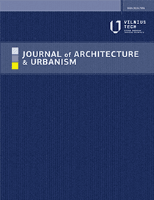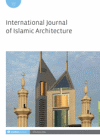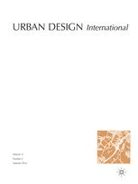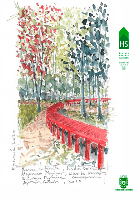
Prostor
Scope & Guideline
Navigating the Complexities of Urban Environments
Introduction
Aims and Scopes
- Architectural Heritage and Preservation:
The journal emphasizes studies on historical architecture and the preservation of cultural heritage, reflecting on architectural styles, significant buildings, and their historical contexts. - Urban Planning and Development:
Research topics include urban design, spatial planning, and the assessment of urban environments, focusing on sustainable development and community needs. - Interdisciplinary Approaches:
Prostor encourages interdisciplinary collaboration, integrating insights from sociology, psychology, and environmental science to enrich architectural and urban studies. - Sustainability in Architecture:
There is a consistent emphasis on sustainable design practices, evaluating the environmental impact of buildings and urban spaces, and exploring innovative solutions for energy efficiency. - Cultural and Historical Contexts:
Papers often delve into the socio-cultural factors influencing architecture and urbanism, examining how historical narratives shape contemporary practices.
Trending and Emerging
- Sustainable Urban Development:
There is a growing emphasis on sustainability in urban planning, as seen in studies evaluating the impact of design on environmental performance and community resilience. - Smart Cities and Technology Integration:
Research exploring the integration of technology in urban environments, including smart city concepts, is on the rise, addressing the need for innovative solutions to urban challenges. - Public Space and Community Engagement:
Papers focused on the design and significance of public spaces, as well as community involvement in urban development, are increasingly prominent, reflecting a broader interest in social sustainability. - Psychology of Space and Human Experience:
Emerging studies explore the relationship between architectural design and human psychology, emphasizing user experience and the impact of spatial configurations on well-being. - Interdisciplinary Educational Approaches:
There is an increasing trend towards interdisciplinary educational practices in architecture and urban design, highlighting the importance of collaboration among various fields.
Declining or Waning
- Post-Socialist Urban Studies:
Earlier themes related to post-socialist urban contexts and their transformations are becoming less frequent, suggesting a shift towards more global perspectives in urban studies. - Historical Architectural Styles:
There has been a decline in the exploration of specific historical architectural styles outside of a preservation context, as modern and contemporary architecture takes center stage. - International Comparisons of Urban Practices:
Comparative studies between different countries regarding urban planning practices have decreased, possibly reflecting a more localized focus on specific regional issues. - Military Architecture Studies:
Research focusing on military architecture and its historical implications has waned, indicating a potential shift towards more civilian and residential architectural studies.
Similar Journals

ArcHistoR-Architecture History Restoration
Championing Scholarly Excellence in Architectural StudiesArcHistoR-Architecture History Restoration is an esteemed open-access journal published by UNIV MEDITERRANEA REGGIO CALABRIA since 2014, focused on the multifaceted domains of architecture, history, and visual arts. This journal serves as a vital platform for the dissemination of research findings, innovative methodologies, and critical discussions surrounding the restoration and history of architectural practices, appealing to a diverse audience of researchers, professionals, and students in these fields. With a commitment to scholarly excellence, ArcHistoR has positioned itself within the academic community, reflected in its ranking in the 2023 category quartiles, where it secured Q4 in Architecture and Q3 in both History and Visual Arts and Performing Arts. The journal facilitates global collaboration and knowledge sharing in its areas of expertise, further underscoring its relevance and significance. Based in Italy, effective communication and cooperation in the restoration community can flourish through the journal's purview. For those dedicated to expanding their understanding and contributing to the discourse on architectural history and restoration, ArcHistoR is an invaluable resource.

Journal of Architecture and Urbanism
Innovating Architecture for Sustainable CitiesThe Journal of Architecture and Urbanism, published by VILNIUS GEDIMINAS TECH UNIV, stands as a pivotal resource for scholars and practitioners in the fields of architecture and urban studies. Since its inception in 2012, the journal has committed to advancing research and discourse on the design, planning, and functionality of urban environments, reflecting a dedicated focus on contemporary challenges in architecture and urbanism. With an impressive open access model implemented since 2018, it ensures that innovative research is accessible to a global audience, fostering collaboration and knowledge exchange. The journal boasts a commendable reputation, categorized in the Q2 quartile for Architecture and Q3 in both Geography, Planning and Development and Urban Studies as of 2023, while maintaining respectable Scopus rankings. Addressing key themes from sustainable design to socio-economic impacts on urban spaces, the journal aims to inspire new models and solutions that meet the evolving needs of growing urban populations. This is a must-read for anyone engaged in the intersection of architecture and urban development.

International Journal of Islamic Architecture
Exploring the Essence of Islamic Architectural HeritageThe International Journal of Islamic Architecture, published by INTELLECT LTD in the United Kingdom, is a pivotal scholarly resource dedicated to the exploration of Islamic architecture, design, and cultural expressions within a contemporary framework. With ISSN 2045-5895 and E-ISSN 2045-5909, this journal targets an interdisciplinary audience by bridging the gap between architecture, geography, urban studies, and the arts. Established in 2012, it has swiftly garnered recognition, achieving notable rankings such as Q3 in Architecture and Q2 in Visual Arts and Performing Arts by 2023. Although it currently does not offer open access, its articles are meticulously peer-reviewed, ensuring high academic standards and relevance. Emphasizing the significance of Islamic architectural heritage in global contexts, the journal seeks to foster innovative perspectives and critical discourse, making it an essential platform for researchers, professionals, and students alike to engage with contemporary architectural practices and cultural dialogues.

METU Journal of the Faculty of Architecture
Shaping the future of architectural studies with impactful insights.METU Journal of the Faculty of Architecture is a reputable academic publication dedicated to advancing research and discourse in the field of architecture. Published by MIDDLE EAST TECHNICAL UNIVERSITY in Turkey, this journal serves as a vital platform for scholars and practitioners, addressing both theoretical and practical topics relevant to contemporary architectural studies. With an impact factor that positions it in the Q3 category for architecture as of 2023, and a Scopus rank of #133 out of 189 in Engineering Architecture, the METU Journal is an influential resource for innovative ideas and studies. Encompassing a wide range of scholarly articles, it fosters academic collaboration between researchers and professionals, making it essential reading for anyone passionate about the evolution of architecture. Though not open access, it provides crucial insights and rigorous research from 2008 up until 2024, contributing significantly to the global discourse on architectural practices and theories.

Bulletin KNOB
Exploring Cultural Narratives Through TimeBulletin KNOB, published by the KONINKLIJKE NEDERLANDSE OUDHEIDKUNDIGE BOND-KNOB, is a reputable Open Access journal that has been disseminating knowledge since 1899, with a continued commitment to making research accessible to all. Based in the Netherlands, this journal provides a platform for scholarly articles that span the fields of Conservation, History, and the Visual Arts and Performing Arts. With its 2023 Scopus rankings placing it in the top quartiles within its category, Bulletin KNOB is recognized for its significant contribution to the advancement of these disciplines. Researchers, professionals, and students alike are encouraged to engage with the journal's diverse content that bridges historical narratives with contemporary practices, fostering a deeper understanding of cultural heritage. The journal’s commitment to excellence is further reflected in its Q3 and Q4 quartile rankings, making it an essential resource for anyone dedicated to the study of the arts and humanities.

Urban Design International
Connecting academia with urban planning solutions.Urban Design International, published by Palgrave Macmillan Ltd, stands as a pivotal journal in the fields of Urban Studies and Geography, Planning and Development. Since its inception in 1996, this UK-based journal has become a leading platform for innovative research and discourse, maintaining a Q1 classification in Urban Studies and a Q2 ranking in Geography, Planning and Development as of 2023. With an impressive Scopus ranking of 48 out of 279 in Urban Studies, the journal's contributions are recognized globally, evidenced by its 82nd percentile standing. While currently not an open-access publication, it provides a vital resource for academics, urban planners, and policymakers engaging with the complexities of urban environments. With an aim to foster interdisciplinary collaboration and critical analysis of urban design practices, Urban Design International is committed to pushing the boundaries of knowledge in sustainable urban development and design.

Revista Habitat Sustentable
Catalyzing Global Dialogue on Sustainable DevelopmentRevista Habitat Sustentable, published by UNIV BIO-BIO in Chile, is a dynamic open access journal that has been contributing to the fields of architecture, engineering, and sustainable development since its establishment in 2011. With an ISSN of 0719-0700, this scholarly platform stands out for its commitment to disseminating high-quality research that addresses pressing issues in sustainability and urban planning. Currently, it holds commendable rankings in several categories, including Q2 in Architecture and Q3 in Urban Studies, reflecting its growing influence and outreach across various disciplines. The journal's mission is to foster interdisciplinary dialogue and encourage innovative approaches to habitat sustainability, making it an essential resource for researchers, professionals, and students engaged in addressing the complex challenges of our built environment. Accessible to a global audience, the Revista Habitat Sustentable is poised to play a pivotal role in shaping future research and policy in sustainable living and development.

ACE-Architecture City and Environment
Innovating for a Greener, More Inclusive Urban LandscapeACE-Architecture City and Environment, published by Universitat Politècnica de Catalunya in Spain, serves as an essential repository for innovative research and insights that intersect the fields of architecture, urban studies, and environmental planning. Since its establishment as an Open Access journal in 2006, it has facilitated widespread accessibility to scholarly work, fostering a collaborative and inclusive academic community. The journal has consistently maintained a prominent standing within its field, reflected in its 2023 Quartile rankings—, Q3 in Geography, Planning and Development, and Q2 in Urban Studies. With a publication horizon extending from 2011 to 2024 and an impressive Scopus ranking among peers, it offers a comprehensive platform for researchers to disseminate their findings and engage with contemporary challenges in urban environments. ACE is pivotal for professionals and students alike, striving to shape the future of sustainable architecture and urban planning through rigorous scholarship.

Estudios del Habitat
Bridging Research and Practice in Urban PlanningEstudios del Habitat is a distinguished academic journal published by Universidad Nacional de La Plata, Facultad de Arquitectura y Urbanismo, dedicated to the exploration of habitat studies, urban planning, and architectural theory. With a commitment to advancing knowledge in the fields of architecture and urbanism, this journal serves as a vital resource for researchers, professionals, and students alike. Although it does not operate under an open access model, the journal seeks to disseminate high-quality research that addresses contemporary challenges in habitat design and urban sustainability. By featuring innovative case studies, critical analyses, and interdisciplinary approaches, Estudios del Habitat facilitates a deeper understanding of the relationship between built environments and their inhabitants, making significant contributions to academic scholarship and practical applications in architecture and urban studies. Don't miss the opportunity to engage with cutting-edge research from Latin America and beyond, where the complexities of spatial dynamics are examined and discussed rigorously.

ICONARP International Journal of Architecture and Planning
Pioneering research for a sustainable and innovative built environment.ICONARP International Journal of Architecture and Planning is an esteemed open-access publication that serves as a pivotal platform for fostering innovative research and discussions in the fields of architecture and urban design. Published by KONYA TECHNICAL UNIVERSITY, FACULTY OF ARCHITECTURE & DESIGN, this journal has been committed to the dissemination of high-quality academic work since 2013, promoting accessibility and global collaboration among researchers, professionals, and students. With its rigorous peer-review process and a focus on contemporary architectural and planning challenges, ICONARP seeks to contribute significantly to scholarly discourse and practical applications within the built environment. The journal is indexed in various scientific databases, enhancing its visibility and impact in the academic community. By appealing to a diverse audience, ICONARP encourages interdisciplinary studies and innovative solutions that address the complexities of modern architecture and urban living.